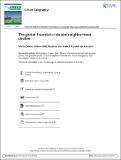Files in this item
The global financial crisis and neighborhood decline
Item metadata
| dc.contributor.author | Zwiers, Merle | |
| dc.contributor.author | Bolt, Gideon | |
| dc.contributor.author | Van Ham, Maarten | |
| dc.contributor.author | Van Kempen, Ronald | |
| dc.date.accessioned | 2016-01-28T13:40:06Z | |
| dc.date.available | 2016-01-28T13:40:06Z | |
| dc.date.issued | 2016 | |
| dc.identifier | 240592958 | |
| dc.identifier | 79523b2c-d836-4a31-94da-25d642e2ac93 | |
| dc.identifier | 84954210207 | |
| dc.identifier | 000379762800003 | |
| dc.identifier.citation | Zwiers , M , Bolt , G , Van Ham , M & Van Kempen , R 2016 , ' The global financial crisis and neighborhood decline ' , Urban Geography , vol. 37 , no. 5 , pp. 664-684 . https://doi.org/10.1080/02723638.2015.1101251 | en |
| dc.identifier.issn | 0272-3638 | |
| dc.identifier.other | ORCID: /0000-0002-2106-0702/work/64697576 | |
| dc.identifier.uri | https://hdl.handle.net/10023/8093 | |
| dc.description | The research leading to these results has received funding from Platform31 in the Netherlands; from the European Research Council under the European Union’s Seventh Framework Programme (FP/2007-2013)/ERC Grant Agreement number 615159 (ERC Consolidator Grant DEPRIVEDHOODS, Socio-spatial inequality, deprived neighborhoods, and neighborhood effects); and from the Marie Curie programme under the European Union’s Seventh Framework Programme (FP/2007-2013)/Career Integration Grant number PCIG10-GA-2011-303728 (CIG Grant NBHCHOICE, Neighborhood choice, neighborhood sorting, and neighborhood effects). | en |
| dc.description.abstract | Neighborhood decline is a complex and multidimensional process. National and regional variations in economic and political structures (including varieties in national welfare state arrangements), combined with differences in neighborhood history, development, and population composition, make it impossible to identify an ideal-type process of neighborhood decline over time. The recent global financial crisis and the subsequent economic recession affected many European and North American cities in terms of growing unemployment levels and rising poverty in concentrated areas. Investments in urban restructuring and neighborhood improvement programs have simultaneously decreased or come to a halt altogether. While many studies have investigated the effects of the financial crisis on national housing markets or on foreclosures in particular US metropolitan areas, only a few studies have focused on how the crisis affected neighborhood change. By proposing 10 hypotheses about the ways in which the economic crisis might influence processes of neighborhood decline, this article aims to advance the debate and calls for more contextualized, empirical research on neighborhood change. | |
| dc.format.extent | 21 | |
| dc.format.extent | 1681399 | |
| dc.language.iso | eng | |
| dc.relation.ispartof | Urban Geography | en |
| dc.subject | Neighborhood decline | en |
| dc.subject | Financial crisis | en |
| dc.subject | Neighborhood inequality | en |
| dc.subject | Housing markets | en |
| dc.subject | GF Human ecology. Anthropogeography | en |
| dc.subject | Geography, Planning and Development | en |
| dc.subject | Urban Studies | en |
| dc.subject | T-NDAS | en |
| dc.subject | SDG 8 - Decent Work and Economic Growth | en |
| dc.subject | SDG 10 - Reduced Inequalities | en |
| dc.subject | SDG 11 - Sustainable Cities and Communities | en |
| dc.subject.lcc | GF | en |
| dc.title | The global financial crisis and neighborhood decline | en |
| dc.type | Journal article | en |
| dc.contributor.institution | University of St Andrews. Geography & Sustainable Development | en |
| dc.identifier.doi | 10.1080/02723638.2015.1101251 | |
| dc.description.status | Peer reviewed | en |
| dc.identifier.url | http://www.scopus.com/inward/record.url?scp=84954210207&partnerID=8YFLogxK | en |
This item appears in the following Collection(s)
Items in the St Andrews Research Repository are protected by copyright, with all rights reserved, unless otherwise indicated.

